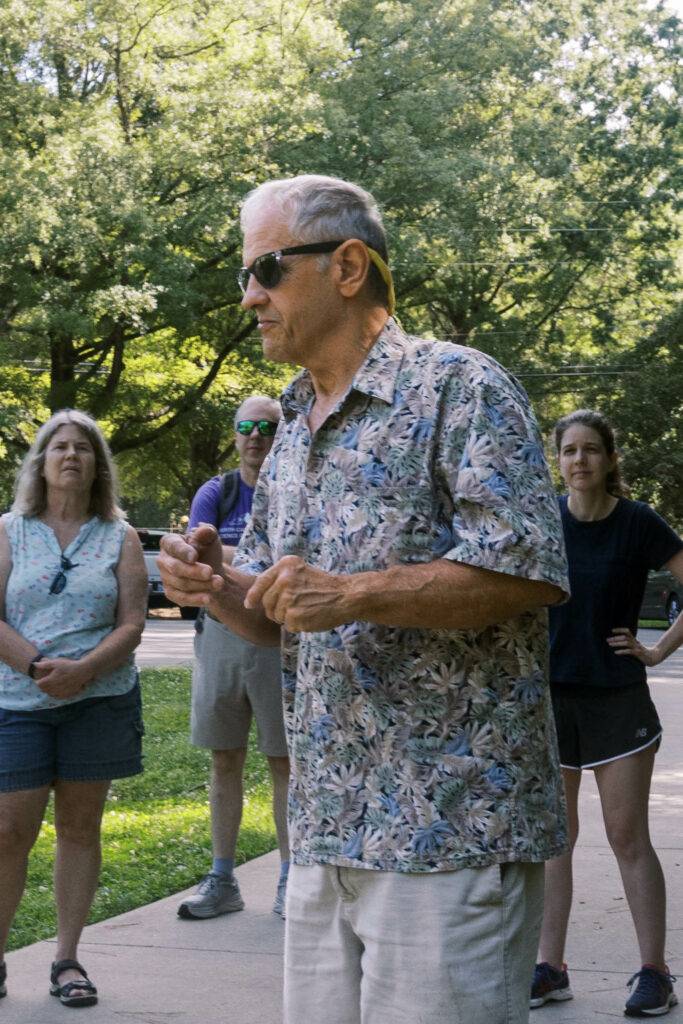This weekend, NEXT hosted a walk along the Chapel Hill portion of the Bolin Creek Greenway near Umstead Park. Our guest for the walk was Bill Webster, who retired in 2020 after spending 39 years working as a parks and greenways planner for the Town of Chapel Hill. Bill was responsible for designing, construction, and land acquisition for nearly every greenway in the Town of Chapel Hill. Now retired, he continues to consult with the town on greenway alignment and design as part of Chapel Hill’s “Everywhere to Everywhere Greenways” initiative.

Sign up for the Carrboro Linear Parks Project mailing list to get updates on building out Carrboro’s greenway network. Visit the Carrboro Linear Parks Project website for more information. There’s also a helpful FAQ with answers to many questions.
Update: We support the creekside alignment for the reasons detailed here.
Our walk started on the bridge over the creek at Umstead Park. Bill relayed that constructing bridges over waterways is always one of the most difficult aspects of greenway projects. This is because of the extensive permitting to ensure that FEMA flood requirements are met.

Bill noted that this particular section of the Bolin Creek Greenway (stretching from Umstead Park to Dr. Martin Luther King Jr. Drive) was very challenging and very expensive to build. But, he added, you have to weigh those challenges against how critical the alignment is for the overall connectivity of the network. In this case, the section along the creek is crucial for connecting residents around Umstead Park to the larger greenway network. The town considered an alternative, which was to convert Umstead Road into a one-way, one-lane road, but this was seen as unworkable.
We spent a good amount of time discussing the best-suited materials for the greenway surface. In floodplains, it is not possible to use natural surface materials like mulch or gravel because they just wash away during large storms. He also noted that the bridge at Umstead Park has a concrete surface, which is superior to the wooden bridges that require a lot of maintenance. (One of the recommendations in the conceptual master plan for building a greenway along Bolin Creek in Carrboro is that the town should consider raised boardwalks in sections prone to flooding. There are concrete boardwalks available for this sort of application.)
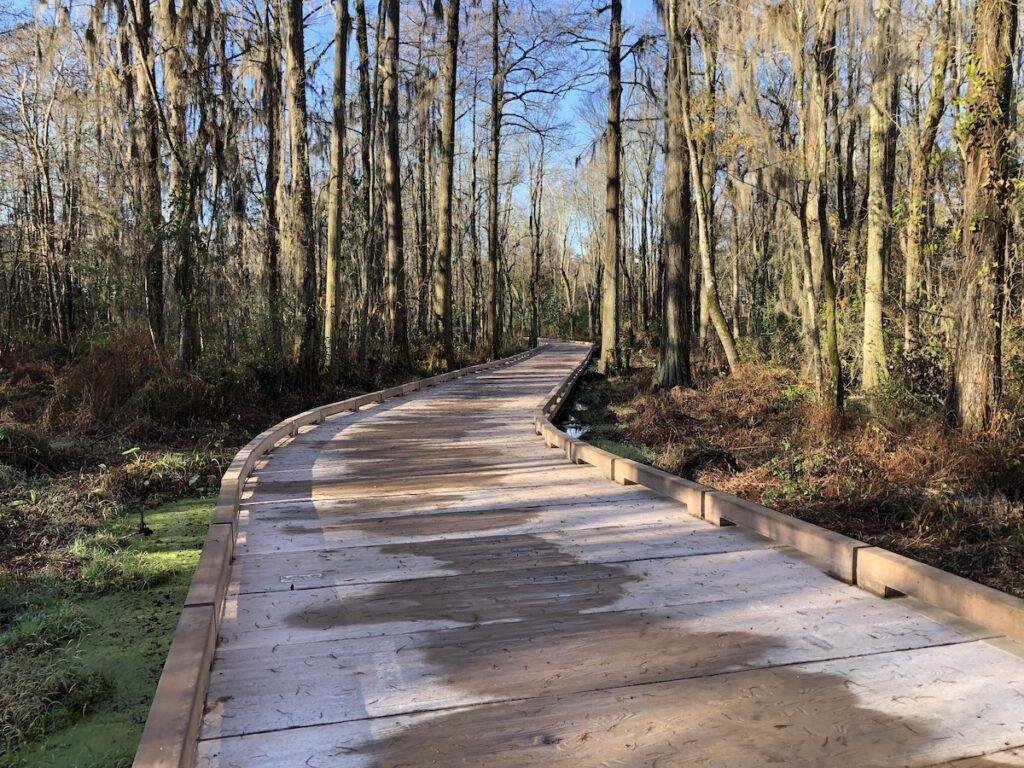
Bill discussed the challenges with using pervious materials, such as pervious concrete that are in some parking lots around town. (The North Carolina Botanical Garden has a pervious parking lot.) The issue with using pervious materials is that they need to be cleaned regularly and are not as resilient as concrete. The cost to maintain a trail built out of a hardened pervious material would be enormous.

As we walked along we noticed a vegetative screen that had been installed by the town to provide separation and privacy to the pool at University Gardens Apartments. Bill let us know that the town often works with residents adjacent to these projects in order to minimize any impact.
We also noticed a fair bit of rock that had been placed at the creek’s edge. When asked about this, Bill highlighted that this rock (often known as riprap) is installed to help stabilize the stream bank by slowing the runoff during high rain events. The Town of Chapel Hill also requires for these projects stone that looks like river rock to be placed near the stream to help maintain the natural feeling trail.
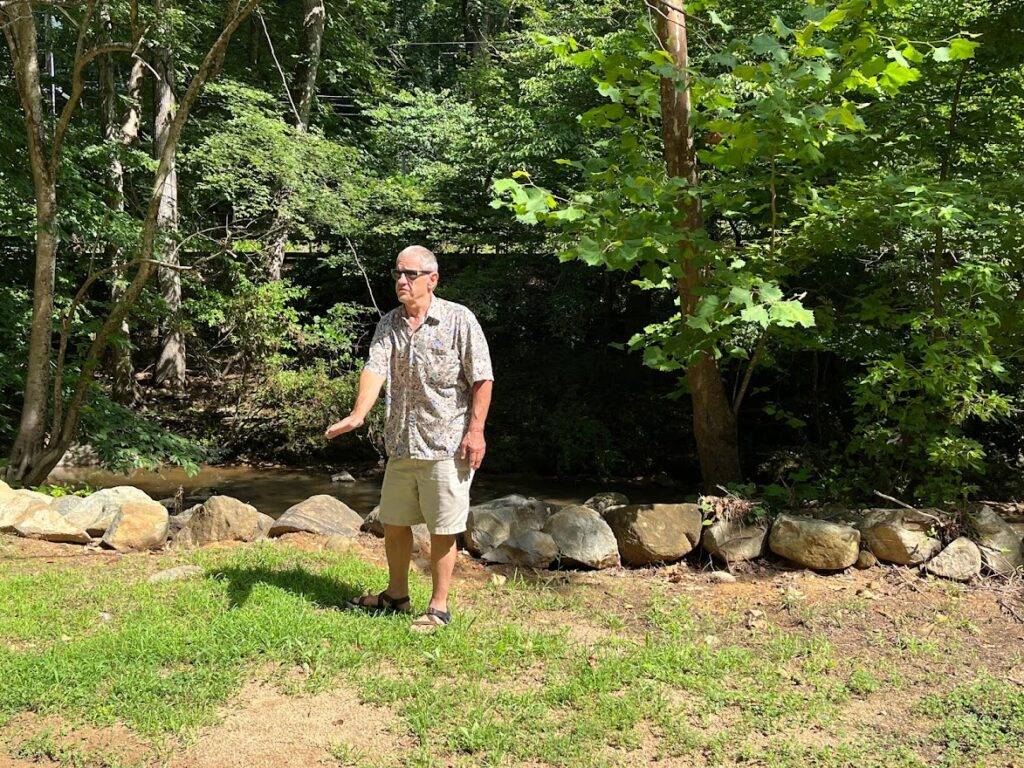
As we emerge from a tunnel Bill points out the high water mark of Hurricane Florence, which occurred not long after the trail was complete. The hurricane did a fair bit of damage to the new greenway, but Bill pointed out that the hurricane exposed some weaknesses in the original design that they were able to go back and fix. Now the trail is more resilient.

Joining us for the walk was Johnny Randall, the Director of Conservation Programs at the NC Botanical Garden. Johnny shared a story about how volunteers dug up trillium that was found along where the trail alignment was planned and replanted them in a nearby area where they continue to grow. Johnny notes that in Carrboro, with proper coordination, it would be possible to deliberately restore nature around the greenway, like locating vernal pools and rare plants. This kind of work also makes the project eligible for other funding sources.
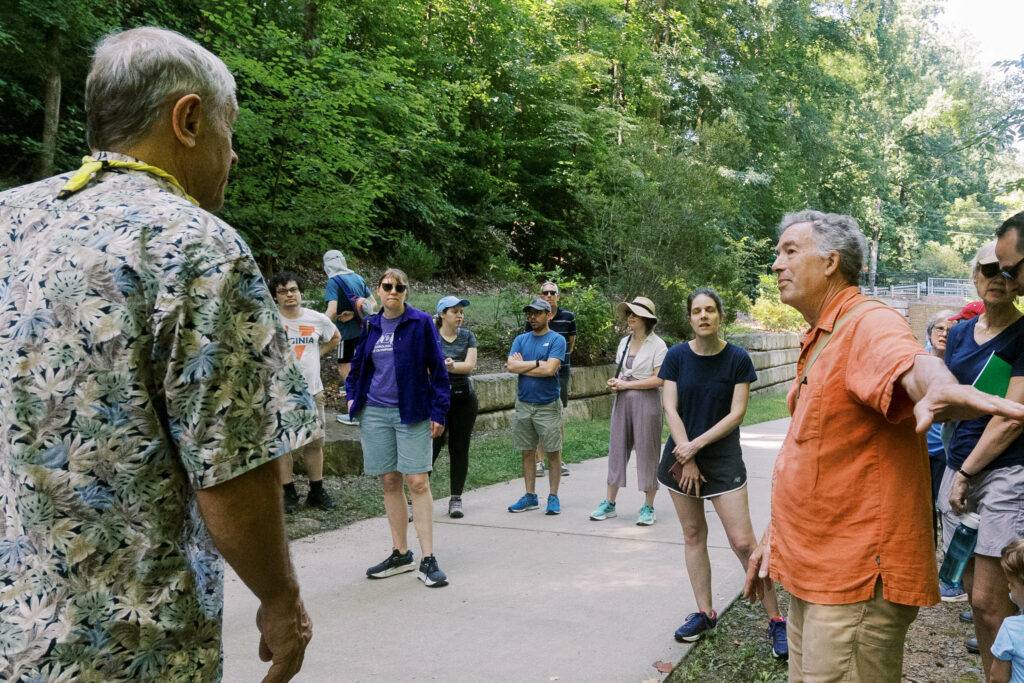
At our furthest point on the walk we stop at a beautiful part of the trail where a steep bank leads to a retention wall and the trail and creek are very close together. This area in particular was seen as impossible to build by some, but the town worked with OWASA closely and was able to accomplish the segment. Bill mentioned that OWASA became extremely easy to work with when Ed Kerwin became the executive director (around 1996) and ever since then the town has had an excellent working relationship with the utility.
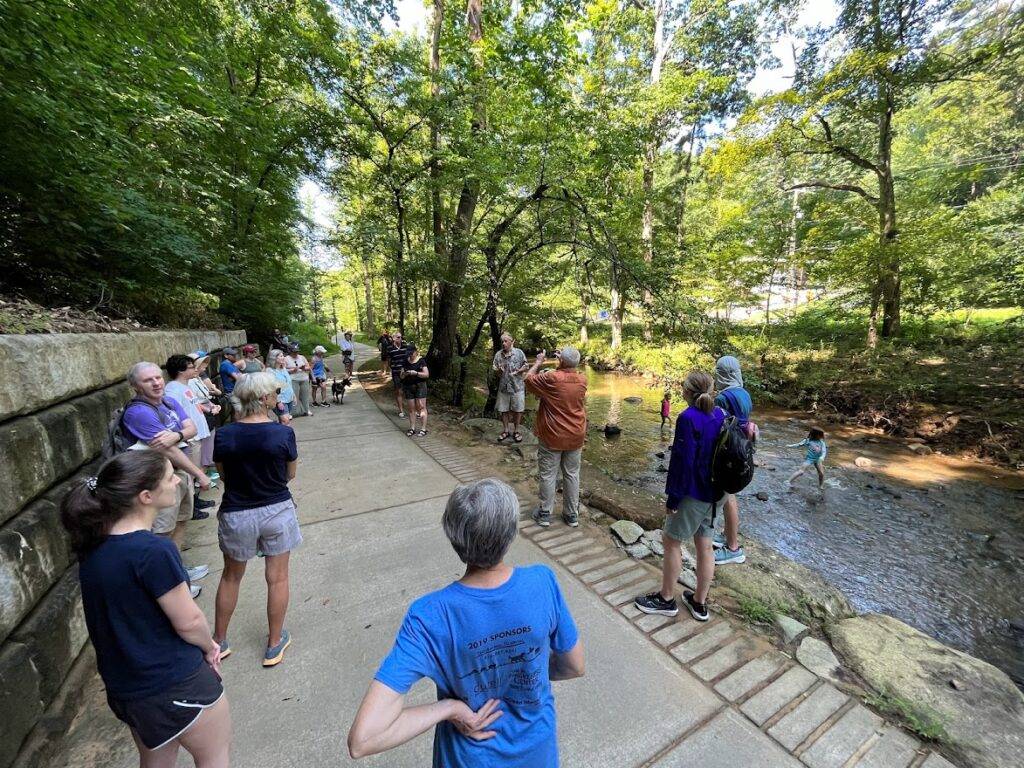
I was able to ask a question that comes up very frequently in discussions about building the creekside alignment of the Bolin Creek Greenway in Carrboro: How many trees were cut down to build the greenway in the existing sewer easement? I asked Bill this question because this segment of the greenway in Chapel Hill is nearly identical to the segment along the creek in Carrboro, which is that the existing sewer easement provides an already cleared 30-50 feet.
Bill responded that there were so few trees cut down that he knew the exact number: fifteen. There were fifteen trees cut down, with less than 12” diameter, to build this section of the Bolin Creek Greenway. The reason the number is so small is because the easement is already cleared of trees. .
A question was raised about funding and grants. Bill notes that this is a difficult aspect of building these trails. There really aren’t many grants available, and North Carolina does not have dedicated greenways funding like some other states (Florida!). Most local greenways are built with USDOT funds that come to the towns via NCDOT.
However, the federal government has awarded a number of greenway projects with federal RAISE grants this year. Chapel Hill received $1 million to design its “Everywhere to Everywhere” Greenways program, and the City of Brevard received an incredible $25 million to complete the Ecusta Trail. The Town of Carrboro could apply for funds like this once the alignment is decided.
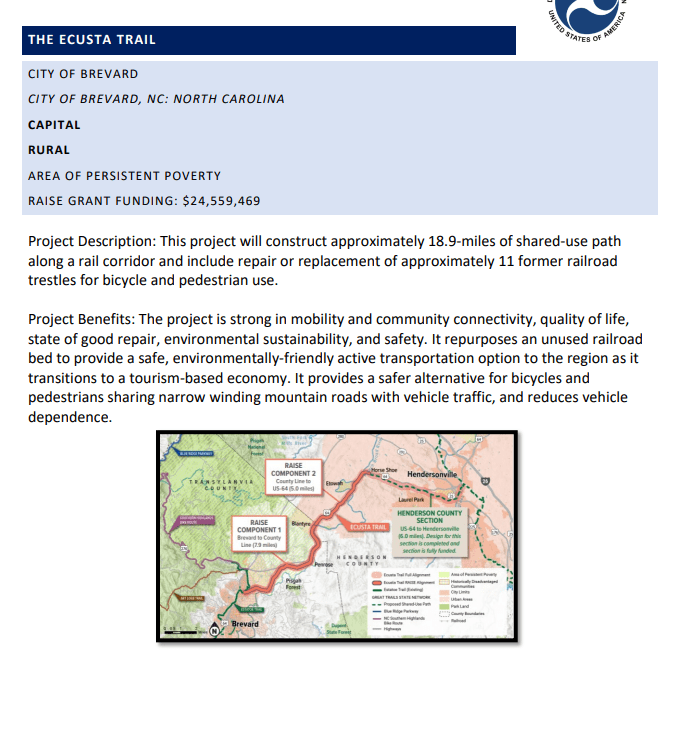
A few times over the course of our walk Bill mentioned that there was opposition to the Chapel Hill greenway by local residents, sometimes fierce opposition. He acknowledged that construction of the greenway can be disruptive but the town does everything it can to minimize those effects. Ultimately, though, residents seem very pleased with the Chapel Hill greenways and use them frequently. During our walk we noticed dozens and dozens of families and friends walking, people exercising, children wading into the creek (including mine!). It’s hard to ignore the positive impact these greenways have had on the Town of Chapel Hill.
Finally, as we were wrapping up, Bill mentioned that he is consulting with the Town of Chapel Hill to extend the Bolin Creek Greenway from Umstead Park to Carrboro at Estes Drive. If Carrboro decides to build the creekside alignment, it would connect the two town’s greenways into a large off-road network that would benefit residents of both towns.
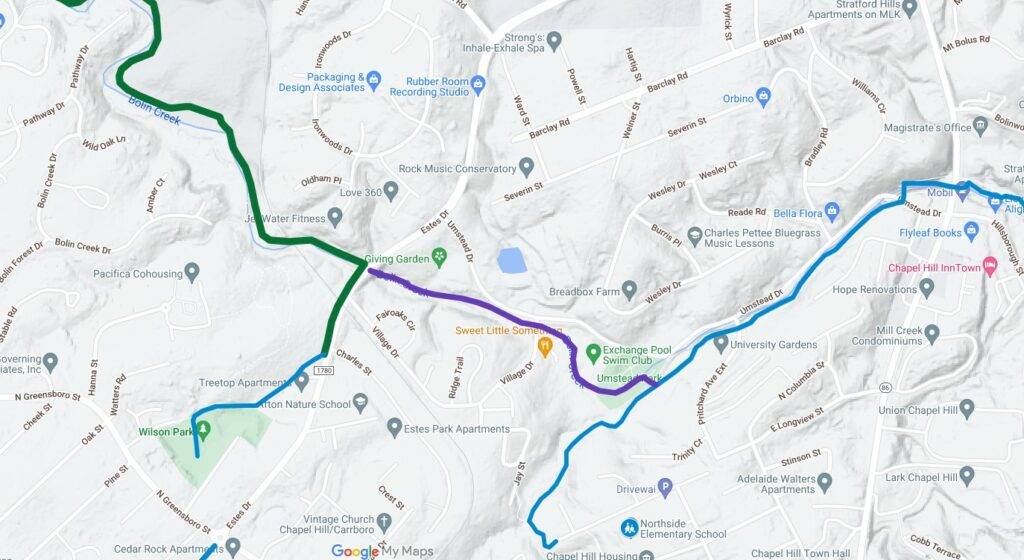
We are very thankful to Bill Webster for taking time out on the weekend to help us understand the in’s and out’s of building complicated greenway projects. The main thing I learned was that it will be difficult and there will be challenges, but the benefits to the town and its residents of all that work is hard to understate.
